The discovery of King Tut’s tomb took place a century ago, but the mysteries and controversies surrounding it still pique the curiosity of the most dedicated archaeologists and Egyptologists.
On November 4, 1922, the tomb of King Tut (Pharaoh Tutankhamun) was officially excavated and is still one of the most famous archaeological discoveries in modern history.
Recently, Zahi Hawass, former Egyptian Minister of Antiquities, gave an interview to NBC and said that archaeologists had recently discovered many coffins, papyrus documents and other artifacts at the Saqqara site in Giza. , near Cairo.
King Tutankhamun (also known as King Tut) was the Pharaoh of the 18th Dynasty of ancient Egypt, reigning from 1332-1323 BC. He ascended the throne when he was only 9 years old and did not reign long, before dying at the age of 18.
It is believed that the boy king had a rather miserable life due to a cleft palate, scoliosis and weak immune system. According to a study, he died from malaria and a broken leg.
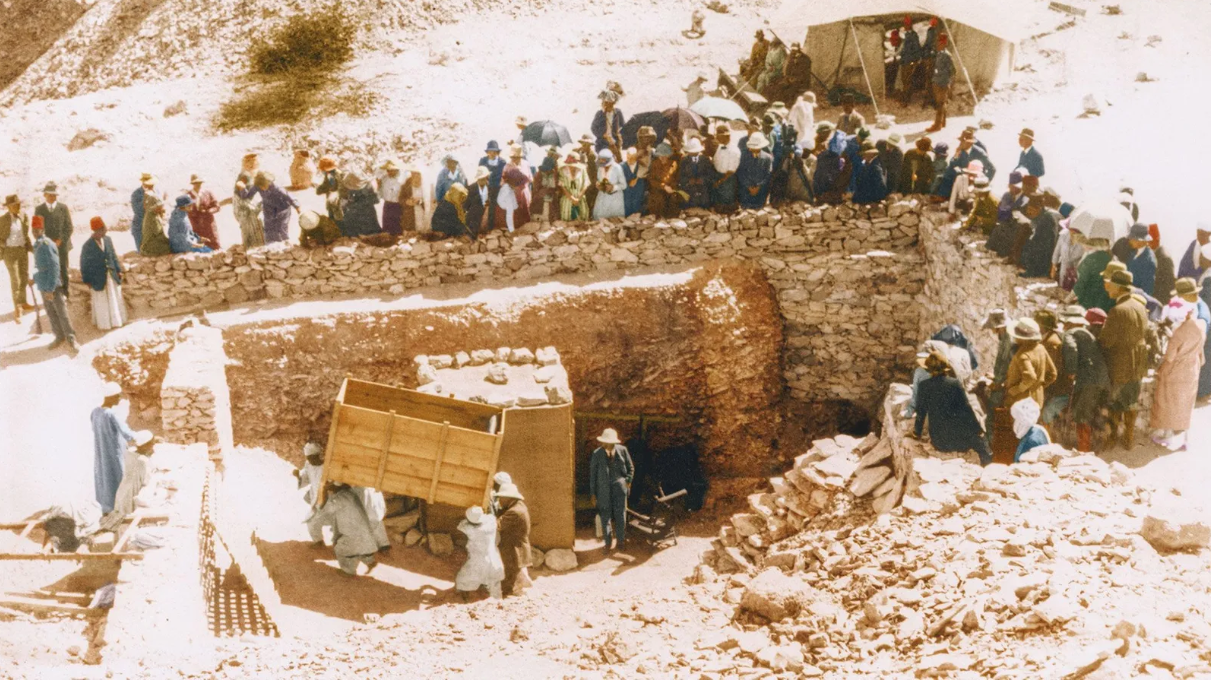
Public gathered outside King Tut’s tomb in 1923 – Source: BBC.
Although his time on the throne was not too long, “the boy Pharaoh” – an archaeological nickname for Tutankhamun, his tomb became an earthquake for archaeologists. To this day, officials and experts in Egypt always believe that we have only discovered a certain part of the tomb, because there are still many mysteries behind the stone blocks and papyrus documents. , relics left behind.
Discoveries beyond your wildest dreams
A century ago, British archaeologist Howard Carter and an Egyptian excavation team found the final resting place of the “boy Pharaoh”. Scholars have been studying the royal tomb and its owners ever since. From this excavation, general outlines of King Tut’s life and times have gradually been revealed.
However, many mysteries remain, including how the young Pharaoh related to Queen Nefertiti (herself a subject of debate), and his influence as a ruler. king or even his death. Now, new findings are emerging and it is hoped that they can fill in the doubts.
But at the same time, more and more controversies and different explanations will continue to erupt.
The key to Tut’s discovery was remarkable perseverance. As of November 4, 1922, Carter and his team had spent five years in vain searching for an undiscovered royal tomb in the Valley of the Kings in Egypt.
Contemporary belief and experience said that everything the valley could contain had been found. But Carter decided to spend his final field season digging up shacks that had once been the homes of ancient tomb builders.
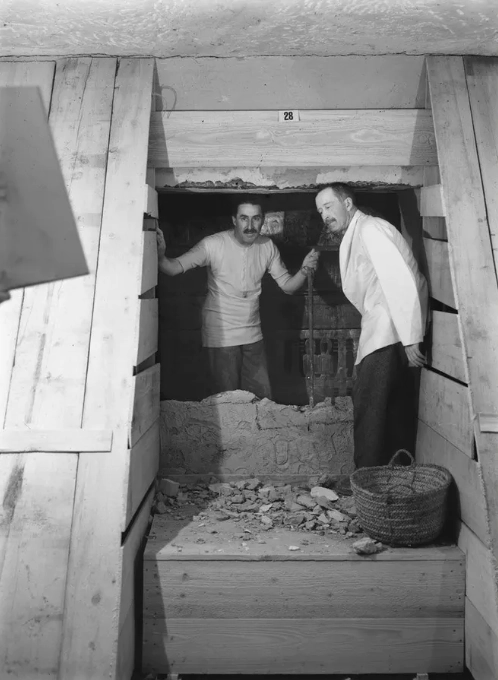
Carter (left) and Lord Carnarvon when they first opened the crypt.
“We had almost decided that we were defeated…” , he and archaeologist Arthur Cruttenden Mace wrote in The Discovery of Tutankhamun’s Tomb, their account of the expedition.
He also did not imagine that the final blows of his and his colleagues’ desperate efforts would lead to a discovery beyond their wildest dreams.
Below those huts, the excavation team discovered a step carved into the rock. Within a few days, they had dug out a steep staircase and a passage about 10 meters long leading to a door sealed with plaster and stamped with the royal cemetery.
Carter had to wait until the group’s benefactor, George Edward Stanhope Molyneux Herbert, 5th Earl of Carnarvon, who sponsored the group’s work, arrived in the field before opening the door. The next day, the team dug out a steep staircase and a door sealed with plaster and stamped with the royal death seal.
On November 24, 1922, the door was opened, revealing a hallway, continuing a more than 10m long walkway to another layer of doors.
Finally, on November 26, Carter cut a small hole in the door and stuck a candle through, shining the first light into the nearly 3,300-year-old room that had been silent in darkness.
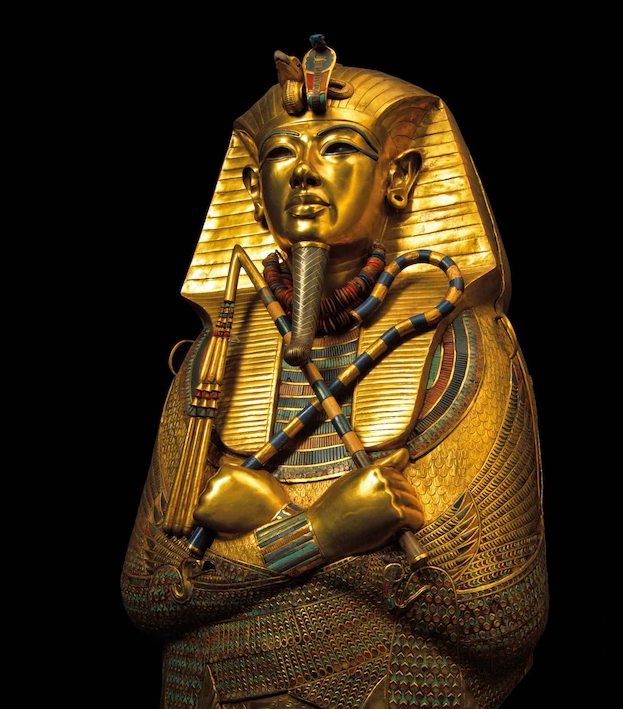
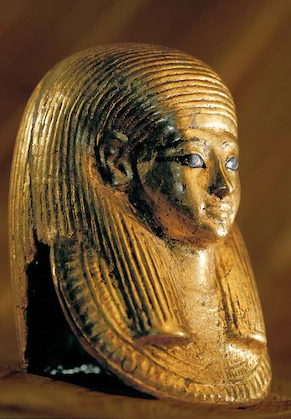
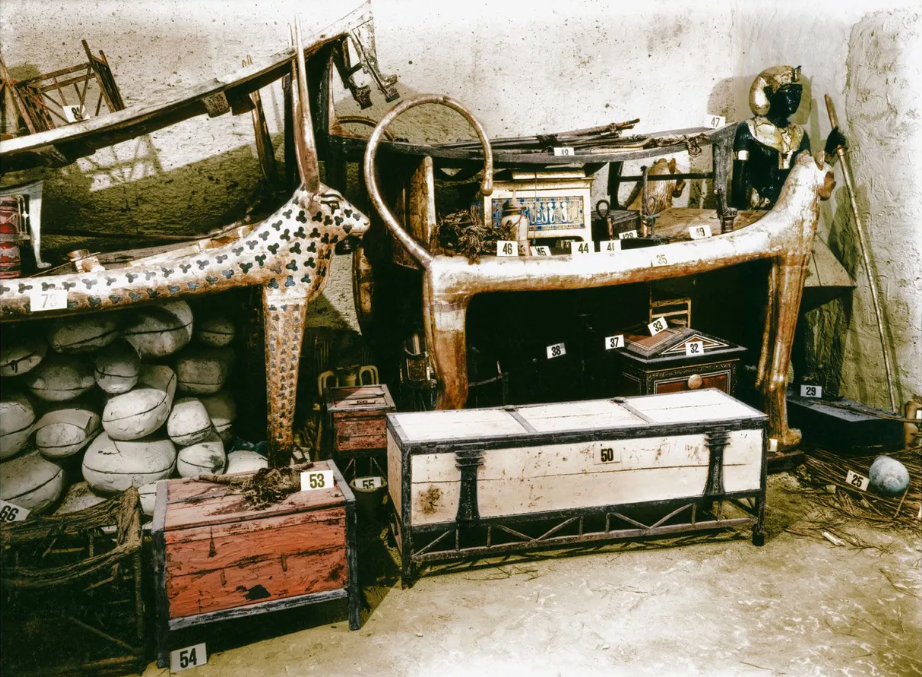
Some artifacts found in the tomb – Source: BBC.
The sight left him speechless as his eyes gradually adjusted to the darkness. “ Details of the room slowly emerged from the mist, strange animals, statues and gold – everywhere was glittering gold,” Carter wrote in the aforementioned book, recalling the moment. I found myself facing the lobby of Tutankhamun’s tomb.
Mysteries surround the young king’s tomb
Carter went on to conduct a meticulous, decades-long study of the four secret chambers that make up the mausoleum and the more than 5,000 artifacts within them. “I am grateful that it was he who found that tomb,” said Egyptologist Salima Ikram of the American University in Cairo . If it had been any other individual, we would have fewer relics left” (perhaps referring to the “requisitioning” of relics by some archaeologists of the time).
Although Carter himself diluted his legacy by taking artifacts from the tomb for his personal collection, he was still more careful in documenting the tomb than with several other excavators working in Egypt at the time.
Carter invited archaeological photographer Harry Burton, who was working with an expedition sponsored by the Metropolitan Museum of Art in New York City, to photograph the tomb’s excavations, recording every detail. room before any items are moved.
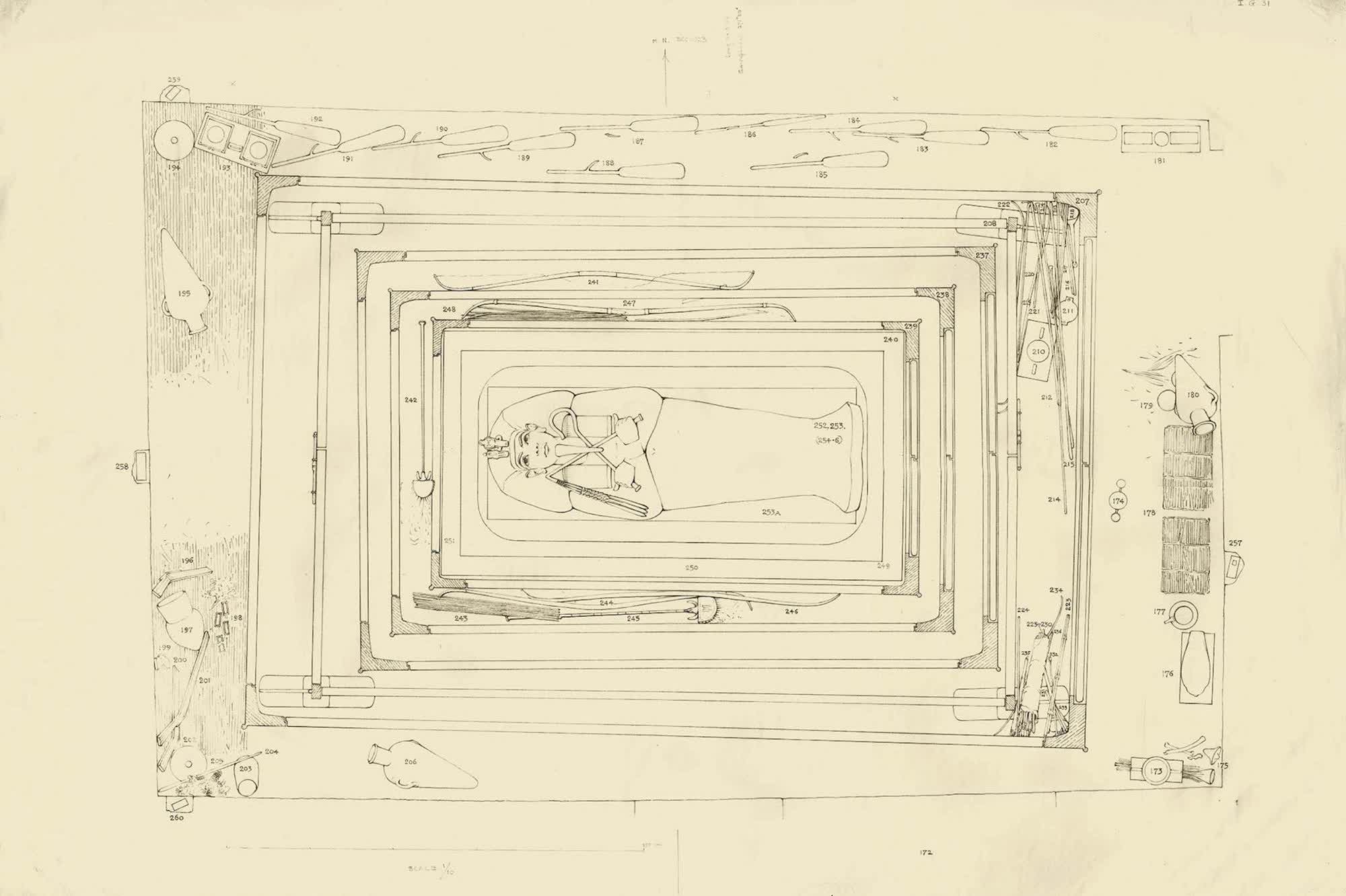
Diagram of the room containing King Tut’s tomb drawn in detail – Source: Oxford University.
Each artifact is numbered and plotted on a map. Mr. Zahi Hawass said Carter “was trained by the most important archaeologist of the time, Sir Flinders Petrie”. Carter’s methods are still used by modern Egyptologists to document tombs or other rooms filled with artifacts, with modifications of course based on technological advances.
Through the work of Carter and his successors, a portrait of King Tut and his family began to coalesce. Tutankhamun was the son of Pharaoh Akhenaten, a man who “revolutionized” the worship of gods and profoundly influenced Egyptian society and economy.
Before his father’s death in 1336 BC, Tutankhamun was named “Tutankhaten”, which means “living image of Aten” (Aten was the god worshiped by Akhenaten). The story of King Akhenaten and his worship of the god, as well as his new city, is also a thrilling subject.
But perhaps most important was King Tut’s relationship with Queen Nefertiti, Akhenaten’s wife, who was often portrayed as having equal power to her husband. Her role as co-ruler of Egypt has made her an object of scholarly attention.
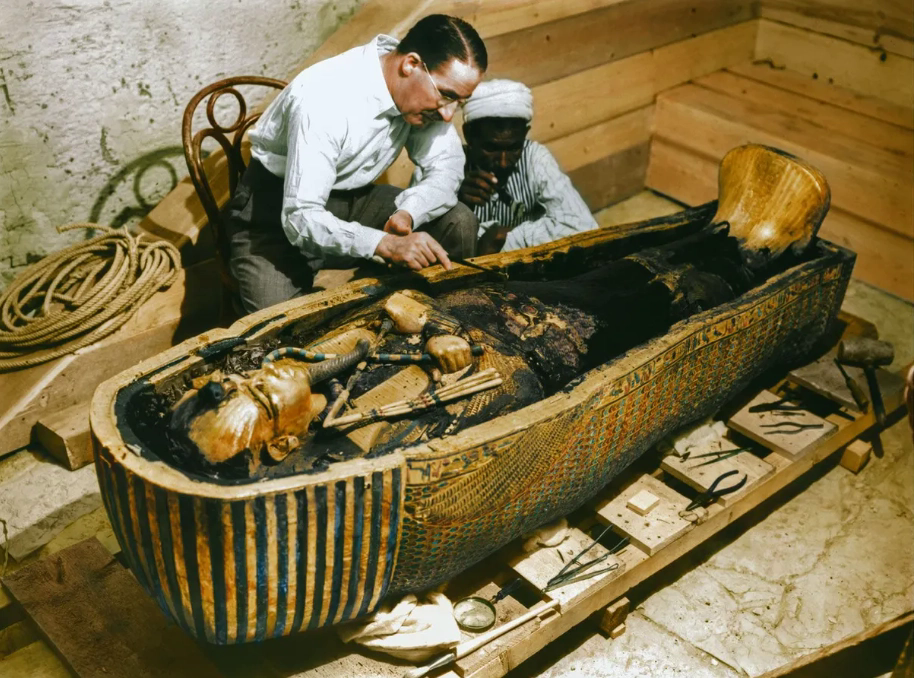
Carter and an Egyptian worker are surveying the third layer of the coffin – the innermost layer of the coffin. Photo taken on October 29, 1925 – Source: BBC.
How her reign ended and how the transition to Tutankhamun’s reign took place are both in the curiosity of researchers. It is suspected that she was not Tutankhamun’s mother; on the contrary, Kiya – a concubine of his father King, is said to have given birth to him.
Amarna artworks depicting royalty often show Nefertiti with daughters but no sons.
After Akhenaten’s death, a mysterious Pharaoh named Smenkhkara ascended the throne. The identity of this ruler is a matter of intense debate. Some Egyptologists speculate that Smenkhkara may have been Nefertiti by using a different name, which would make her one of the very few women to single-handedly rule Egypt. “I think it is possible that Nefertiti ruled as a king,” Ikram said .

Photo on the left: King Tut and Ay (his successor) performing an ancient ritual; Right: Statue of Horemheb (the person behind) and god Amun – Source: NatGeo.
A pottery fragment called Smenkhkara, found by Hawass’s team in a city called “Brilliant Aten” near the Valley of the Kings, supports this view. “ This is a really big discovery because we didn’t know who Smenkhkara was,” Hawass said. I believe that now Smenkhkara may be Nefertiti . ” A small statue of a female ruler found in Tut’s tomb reinforced Hawass’s beliefs.
It is not uncommon, he said, for a ruler to change their name after a major political change during his reign. Hawass said another Queen, Hatshepsut, also changed her name to assume the identity of a male king more than 100 years before Nefertiti.
Smenkhkara only ruled for about 4 years. Then, in 1332 BC, Tutankhamun ascended the throne at the age of eight or nine to preside over a turbulent nation.
Egyptologists have speculated that he was a puppet king manipulated by older men who had been his father’s advisors: Ay, who would become Tutankhamun’s successor as Pharaoh, and Horemheb, his general. Egyptian army and Ay’s successor a few years later, because his major changes in religion and moving the capital were too difficult to be the young king’s idea alone.
Some new discoveries about King Tut’s life could not come true without DNA analysis technology. Previous studies of ancient DNA obtained from King Tut and many other royal members have revealed clues about the family’s inbreeding habits.

Current view of King Tut’s tomb – Source: Smithsonian.
Currently, Hawass is still actively researching the DNA of two unidentified mummies found in the Valley of the Kings. He believed it was Nefertiti and Queen Ankhesenamun, Tutankhamun’s wife. Hawass expects to have the results of the DNA analysis in December. If the mummies belong to members of Tutankhamun’s family, the work could resolve some questions about his relationship with Nefertiti and his members. other during the dynasty.
However, DNA evidence may not solve the problem. Ikram said that the generations of inbreeding that occurred among Egyptian royals limits the conclusions that can be drawn from genetic research.
Despite 100 years of research and technological advances, many questions about Tutankhamun still hang in the air for researchers – including the cause of his early death between the ages of 17 and 20. Researchers have proposed all sorts of imaginative theories for it, from assassination to a carriage accident to a hippopotamus attack.
According to Ikram, CT scans of King Tut’s mummy do not provide a definitive answer. Yet he died while the most important legacy of Tutankhamun’s short reign may have nothing to do with ancient Egyptian religion.
The important thing is, King Tut has become an irreplaceable tourist heritage for this country even though more than 3,000 years have passed. “Tutankhamun, I swear to God, is the best Egyptian Pharaoh because he is the one who made the country’s economy boom since 1922, tell me any other king who can do that” – Ikram conclude.





